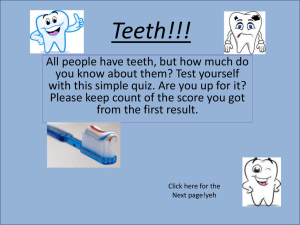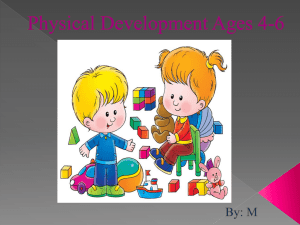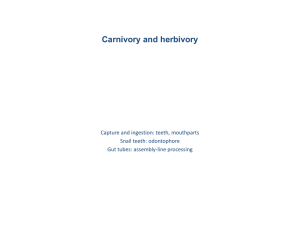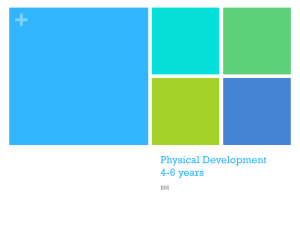Oligodontia
advertisement
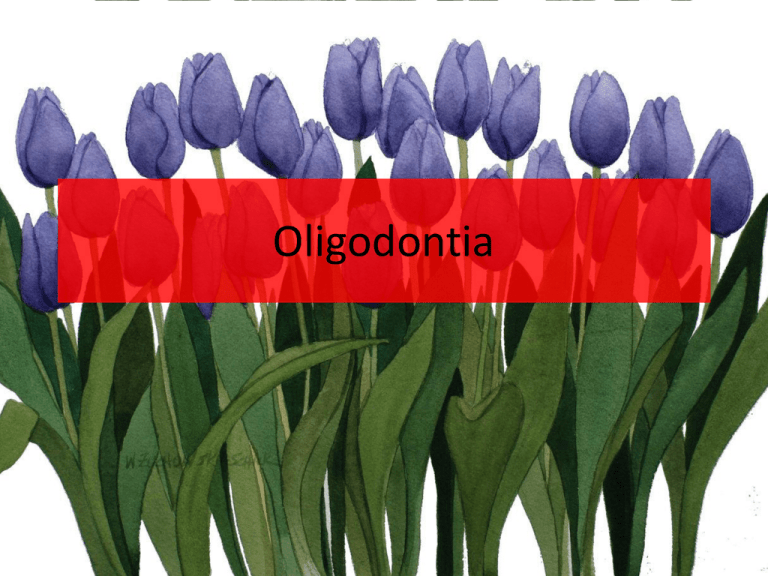
Oligodontia Oligodontia definition • There is no official classification for missing teeth. • In today article the patient is missing 8 teeth • Hypodontia : the most common term, it is often used to describe every condition, including the absence of all teeth (anodontia) - Mild 1 to 2 teeth - Moderate 3 to 5 teeth - Severe more than 6 teeth Oligodontia definition • Oligodontia has been proposed for describing the absence of a larger number of teeth • This number following the hypodontia classification is fixed to 6 teeth • Oligodontia has been further divided by other author between syndromic and non syndromic - Isolated hypodontia/oligodontia (non syndromic) - syndromic hypodontia/ oligodontia • There is also geographic variation - oligodontia is more often used in Europe - Agenesis is more often used in U.S • When reading a transfer file or a publication be careful with those term if they are not precisely defined as they can reflect different reality Oligodontia Prevalence primary dentition • Low incidence between 0.1-0.9% of the population • Equal distribution between male and female • More frequent in the anterior maxilla, the lateral incisor are the element most frequently missing • Often associated with hypodontia of the permanent dentition • Hypodontia is often associated with syndromic condition • consequently missing lacteal teeth must not be dismissed has being not important Oligodontia Prevalence permanent dentition • The distribution vary with different population • Agenesis are more frequent with women, the ratio is quite constant between different population at 1.3-1.4 • Those two factor indicate that there is probably a strong genetic influence to agenesis Oligodontia Prevalence permanent dentition • The teeth the more often implicated are in decreasing order • Mandibular second premolar 3% • Maxillary lateral incisor 1.7% • Maxillary second premolar 1.5% • Mandibular central incisor 0.3 % • Mandibular lateral incisor and maxillary first premolar 0.2% • Mandibular second molar and maxillary canine • The trend is of course that the more distal element of each group is the one that will have the more chance of being absent Oligodontia Prevalence permanent dentition • - In case of hypodontia : 1 to 2 teeth missing 83% 3 to 5 teeth missing 14.4% 6 and more teeth missing 2.6 % or 0.14% of the general population Oligodontia Prevalence permanent dentition • When a teeth is missing it will be bilaterally - For the maxillary central incisor in 54% it is the only teeth that has more than on chance in two to be bilaterally missing - The second maxillary premolar 49.25% - The second mandibular premolar 45.6% - The mandibular second incisor 41.2% • When two teeth are missing we are thinking agenesis and when only one is missing we think accident or tooth decay. • But in fact agenesis of only one dental element is the most frequent case Oligodontia Aetiology • Occasionally can be associated with environmental factor but the main etiology is genetic • The genetic basis is not well understood but hypodontia is frequently identified as a familial trait • The presence of hypodontia in individual without family history suggest that it can happen as the result of a spontaneous genetic mutation • Hypodontia is linked to small teeth size which suggest that it is part of a continuum. under a certain size teeth germ will not develop themself leading to a missing teeth. Oligodontia Aetiology • Hypodontia is associated to syndromic condition : - Hypohidrotic ectodermal dysplasia 1 (HED) and 3 (EDA3) - Incontinentia pigmenti (bloch-Sulzberger syndrome) - Cleft lip/palate- ectodermal dysplasia syndrome - Witkops syndrome (tooth and nail syndrome) - van der Woude syndrome (lip-pit syndrome) - Oral-facial-digital syndrome (OFD) - Rieger syndrome - Down syndrome - Book syndrome - Holoprosencephaly Oligodontia Features microdontia • Microdontia : characterised by smaller than normal teeth • Abnormal shape is also frequent - Crown : tendency to paralle side or inclined toward the occlusal table - Root : shorter than usual and abnormal form - There is a lack of dental tissue - All or only some of the teeth can be affected with varying degree • Microdont teeth present a reduce surface area of enamel, that can be problematic for reconstructive technics • Because of the combination of missing teeth and reduce size of the remaining element there is discrepency between the skeletal base and the dental base Oligodontia Features Conical teeth • As microdontia can affect one or several teeth • As with microdontia can be genetically determined but can also have systemic or local causes • In case of conical teeth two problem must be address - it is highly non esthetic - can lead to trauma • The point can be remove to avoid trauma , but care must be taken as there is a very narrow pulp • Restorative material or overdenture can be used Oligodontia Ectopic eruption • Ectopic eruption of permanent teeth is common in hypodontia and is probably caused both by the lack of adjacent teeth to guide the eruptive process and of spaces in which they may erupt • This can lead to esthetic and functional problem • This can usually be corrected (but not always) with orthodontic treatment and surgical exposure if necessary • A classic case is the eruption and migration of the maxillary canine mesially when the incisor are missing • In this case the permanent mandibular canine erupted in place of the incisors Oligodontia Retained primary teeth • Delayed eruption of permanent teeth is a feature of hypodontia • If the permanent successor is missing, primary teeth can be retained for long time, sometime even in the fourth and fifth decade • If the permanent successor is not present the primary teeth still have high chance to undergoing root resorption • But the rate of resorption will be variable depending of the teeth, age and patient Oligodontia Retained primary teeth • • • • • • • • • Canine Up to age 35, 60-80% have minimal root resorption 20-40% less than half the root resorbed After 35 years the root resorption is likely to increase Primary molar up to age 12 20% have minimal resorption and 80% have more than half the root resorbed Secondary molar Up to age 24 40-60% have minimal root resorption the rest will have less than 50% root resorption When doing the treatment planning keep in mind that even if at the present time there is no root resorption on a lacteal teeth root resorption will happen with time • In this patient case (15 years old) • The root of 84 is almost entirely resorbed • 85 root more than half • 65 root is almost intact Oligodontia Retained primary teeth • Retained teeth can give satisfactory service for many year • The descision to extract or not must be based on case by case basis • The most common trouble are : - loss of dental tissue resulting in unesthetic appearance and supra occlusion of the adjacent - Retained primary teeth frequently become ankylosed and consequently infra-occluded - The ankylos lead to a failure of developement of the alveolar process - Severly infra occluded teeth can be difficulte to removed and will lead to further loss of alveolar bone Oligodontia Ankylosis • Ankylosis is an anatomical fusion between cementum and alveolar bone • It prevents the normal compensatory eruptive mechanism that maintains the level of the occlusal plane during continued vertical skeletal development • Without compensatory mechanism an ankylosed tooth became infra-occluded • The seems to be a genetic component to the condition as if a child is touch by the condition, the sibling have a high probability of being touch also • The prevalence have been reported to be between 1.3% to 8.9% • Their seems to have a higher prevalence in subject with hypodontia suggesting a common mechanism Oligodontia Ankylosis Feature Consequence Infra-occluded primary molar • Delayed exfoliation • Progressive infra –occlusion • Difficulty with extraction Permanent successor • • • • • Delayed eruption or impaction Abnormal eruption pattern Disturbed root development Rotation of successor Cyst formation Developing occlusion • • • • • • • • Potential site for developing malocclusion Midline shift Over eruption of opposing tooth Tipping of adjacent teeth Localized open bite Reduced vertical alveolar bone development Impaired mastication The condition is also associated with a higher frequency of impacted maxillary canine, ectopic first permanent molars Oligodontia Ankylosis • QUIZ • How do you determined if a teeth is ankylosed ? Oligodontia Ankylosis 1 looking for a step in the occlusal plan • It is not sufficient for making a diagnosis, as the crown of the primary is shorter than that of the permanent Oligodontia Ankylosis 2 Percussion : • Not reliable at least 20% of the root surface must be ankylosed before a clear metallic sound can be heard 3 Mobility testing • Not reliable at least 10% of the root surface must be ankylosed before the mobility is affected 4 obliteration of periodontal membrane on a peri-apical film • unreliable as it is a 2D image. The bucco lingual aspect of the root can not be check Oligodontia Ankylosis 5 The most reliable indicator of ankylosis in a mildly infra-occluded tooth is the presence of a vertical step in the interproximal bone around the infra occluded molar. This signifies a cessation of vertical bone formation normally associated with eruption The tension of the trans gingival fiber is thought to favorise de the version of the adjacent teeth Oligodontia Ankylosis So in the case of this patient the X ray told us that their is probably no ankyolsis. Oligodontia Ankylosis Any other way to assess ankyolsis ? • 3D X-ray can allow to check the totality of the periodontal ligament • Orthodontic treatment : as long as the teeth move during the treatment it is not ankylosed Oligodontia Tooth surface loss • This occur mainly on retained primary teeth due to their composition • Can also affect permanent teeth this is due : - there lesser number which mean that the remaining element will have to support more mechanical stress - Subject with hypodontia are also subject to microdontia, the stress will therefore be more important due to the smaller surface of the occlusal table - Those two factors lead to an increase attrition and abrasion of the teeth which in turn increase stress - Tooth surface loss can lead to an increase in freeway space Oligodontia Reduce alveolar development • • • • • In case of anodontia the alveolar development will not take place the aspect will be similar to a space with have stay edentulous for some time In only the primary teeth is present, the development of the alveolar bone will be less because the stimulus of the larger permanent teeth is not present the primary will often become ankylosed leading to a stop of the development of alveolar bone The extraction of the ankylosed element will lead to further loss of alveolar bone In some individuals with hypodontia, alveolar development is less than normally, even in the presence of permanent teeth The reduce alveolar development can lead to trouble when orthodontic, prosthodontic or implant are planned In some case it have to be address prior to those treatment Oligodontia Increased freeway space • Unusual in hypodontia patient but a study report that 10% of patient referred to a specialist clinic for the management of hypodontia had a clinically determined freeway space of 5-7 mm and a further 4% were in excess of this • Consequently the lower incisor can be not visible in function • The cause are a occlusal plan closer to the alveolar bone than usual • This impact mainly the appearance giving a close configuration pattern • Function and speech can but are rarely impacted • This can be treated with overdenture in young patient • For adult or definitive treatment, implant, bone grapht and surgery can be necessary Oligodontia Delayed eruption of permanent teeth • This is a recognize feature of hypodontia even if few data exist on the phenomenon • This is of importance when the timing of the treatment is dependent of the eruption of a particular teeth • This also mean that the absence of a teeth must be assessed radiologically Oligodontia Altered craniofacial morphology • Several study have shown that the craniomorphology of the patient with hypodontia is different from the general population • Different study report : - reduced maxillary and mandibular length - reduced mandibular-cranial base length ratio - Tendency to class III skeletal relationship due to the retrusion of the maxilla and relative prognathism of the mandible - Reduction of the anterior facial height due to forward mandibular growth rotation (FMPA, SNMP) Oligodontia Soft tissue • • The contours of the cheeks is influence by the teeth The vertical dimension at rest and occlusion The lack of posterior teeth lead to a lingual collapse of the cheeck giving an appearance similar to an edentulous patient • An excessive freeway have the same effect, it also lead to an anterior rotation of the mandible in occlusion Oligodontia Soft tissue • Patient with large freeway space in repose • In occlusion the lip display and the vertical dimension are markedly reduced Oligodontia Soft tissue • There is a general lack of dento alveolar tissue • These lead to a deep • This patient has overbite an excessive freeway space and due to lack of reduced posterior OVD support Oligodontia Soft tissue • overdenture were put in place for recreating the lost tissue • There is a very good improvement on the soft tissue Oligodontia Patient complain • Appearance - appearance of the teeth : microdontial, retained primary teeth, conically shaped tooth, ... - Spacing : can be aggravated by cause non related to hypodontia (such as unfavorable skeletal pattern) - Excessive freeway space : lead to collapsed lower third of the face, thus mimicking the aspect of older patient Oligodontia Patient complain • Speech problem : relatively uncommon even if the missing tissue can make the pronunciation of certain word difficult. On exception is during the stage of speech acquisition, in this case an overdenture can help • Difficulty with mastication: Note reported, it is probable as it is reported with edentulous patient. One explanation is that hypodontia patient lack the basis for comparison Thank you





